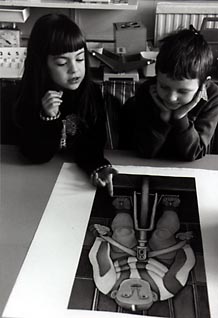Content: What is the work's content in terms of subject matter? How significant is this? How has the artist accumulated the necessary information?
Form: What are the formal qualities of the work in terms of its visual elements: colour, shape, pattern, etc? What are the physical properties of the work, for example, its size and shape?
Process: Examine the techniques, processes, methods and time scales involved in making the work.
Mood: Investigate the mood, atmosphere and feelings evoked by the work.
This model could be revised and adapted to fit almost any art form. Here is an example of an adapted version of the model in action.
"What can you see? Look at the painting, just tell me all the different things you can see. We can make a list. Mention all the obvious things as well. For example, if there is a sky, say 'there is sky'.
Now let's talk about the colours in the painting. What colours can you see? What are the colours like? For example, are the colours bright, natural, artificial, muted, hazy, dark? How would you describe the colours? Are the colours the same all across the painting or is one area softer and paler than another? Now tell me about the space in the painting. Which part of the painting looks the furthest away from you? Which part is the closest to us? Can you tell me which part of the painting has the darkest tones and which has the lightest. Are there shadows or highlights. Which direction is the light coming from, can you tell?
How do you think the artist put the paint on? Did he work quickly with a large brush or slowly and painstakingly with a tiny brush. What kind of brush strokes did he use? Little dashes and dabs or big sweeping strokes? Was the paint thick, watery or thin? Did the artist mix lots of colours or only use a few? Is the painting the same all over or are some areas painted in different ways from others?
What is happening in the painting? What is going to happen next? If you were there in the painting and the painting was real, what would it be like? How would you feel? Look at the portraits in the painting. What kind of people do you think they are? If you met them what would they be like and how would you feel? Does the painting have an overall mood?:"
These are just a few ways teachers and children could discuss a painting. However, Taylor's model does not emphasise a fifth and vital area for discussion. The children must be asked about their own opinions and judgements on the work. For example you could end the discussion with questions like these:
"Do you like the painting? Do you dislike the painting? Can you say why? Are there parts of the painting you like more than others? Do you especially dislike a part of the painting? Do you think the painting works as it stands or would you change anything about it? If you were able to talk to the artist what would you say about the painting? If you could take the painting home would you hang it on the wall so that you could see it every day? How does the painting compare with others you have seen? Is it one of the best, or not?"
There can be great argument and debates about the relative quality of the painting in the children's eyes. It is very important to value the pupil's opinions. Many adults really dislike work hung as prime examples of good quality and taste in our major museums.
The most important reason for talking about art is that the barriers between the child and the art can quickly fall. The works are often not mysterious or difficult . Down to earth talk can do much to demystify art. Listing what can be seen in a painting will help children feel they have something to say about the work.
- Directly compare two or more paintings using a structure of questions and discussion based on the above.
- The work can be with a whole class or you might prepare questions for a group to discuss.
- Why not ask an individual child or group to prepare a radio report about the painting. This can be tape-recorded and played back to other children. Did the report accurately describe the painting? Did it answer your questions about the work? Did the reporter leave something important out?
- This unit is written using painting as an example. The ideas can be adapted for any work of art, craft or design.
- Also look at 'questions and talk about art', 'talking about space', 'talking about a landscape painting', 'visiting a gallery or museum' and using children's book illustrations'.
- What can you see? How do you think it was made? What do you think the artist was trying to do with it? Is it like anything else you have seen? What do you think of it? What do other people think of it? Would you want to do something like it or very different from it?
Reproductions of paintings or, better still, a visit to an art gallery or museum.


